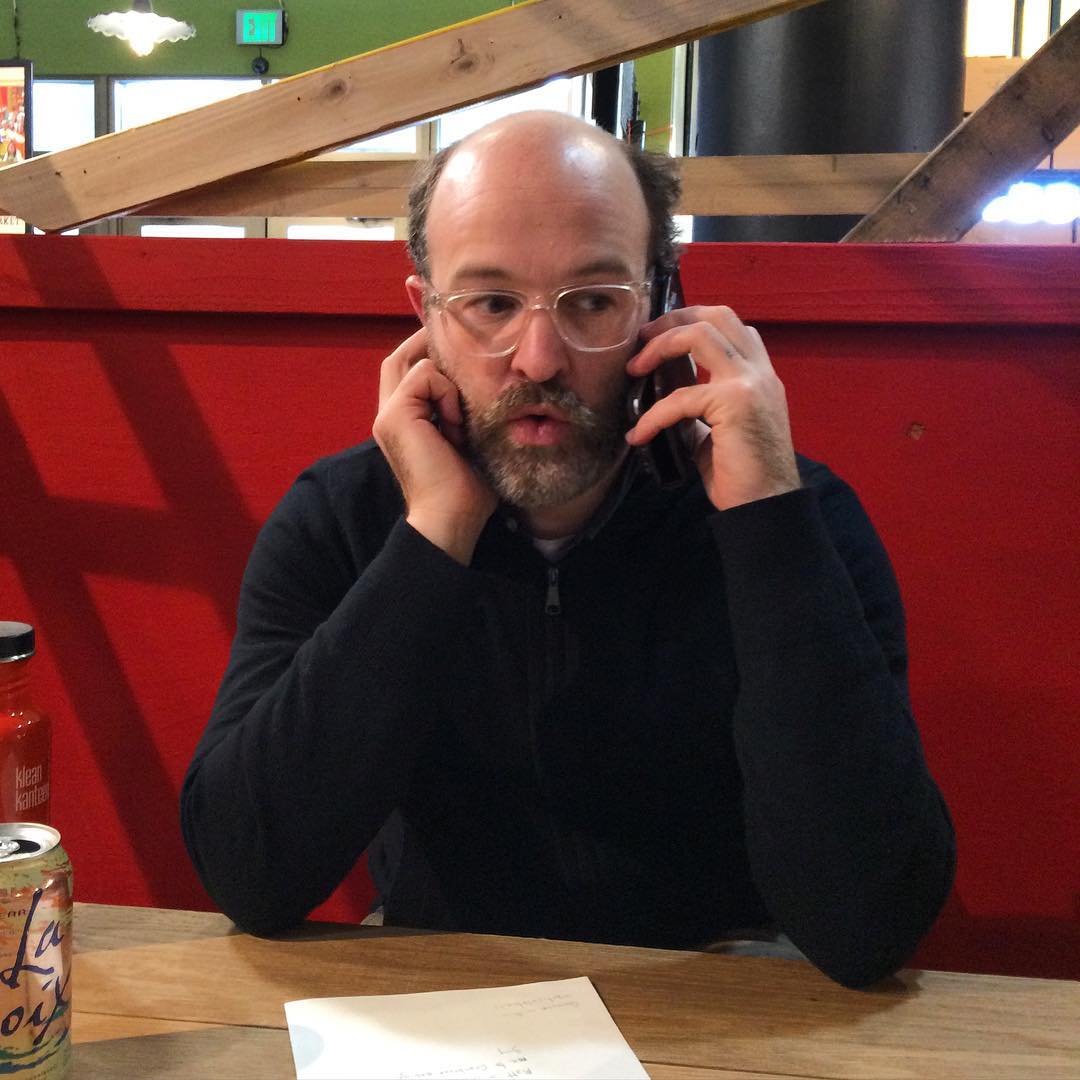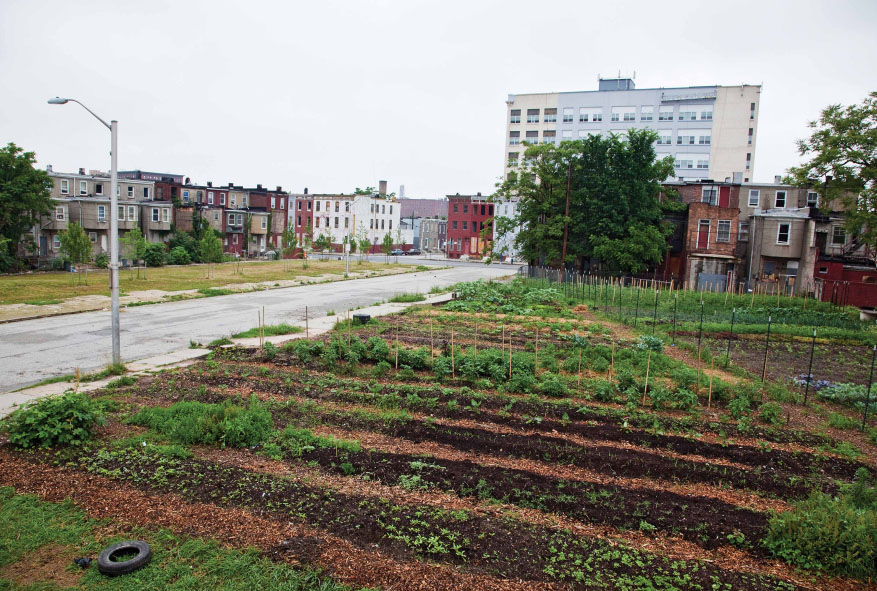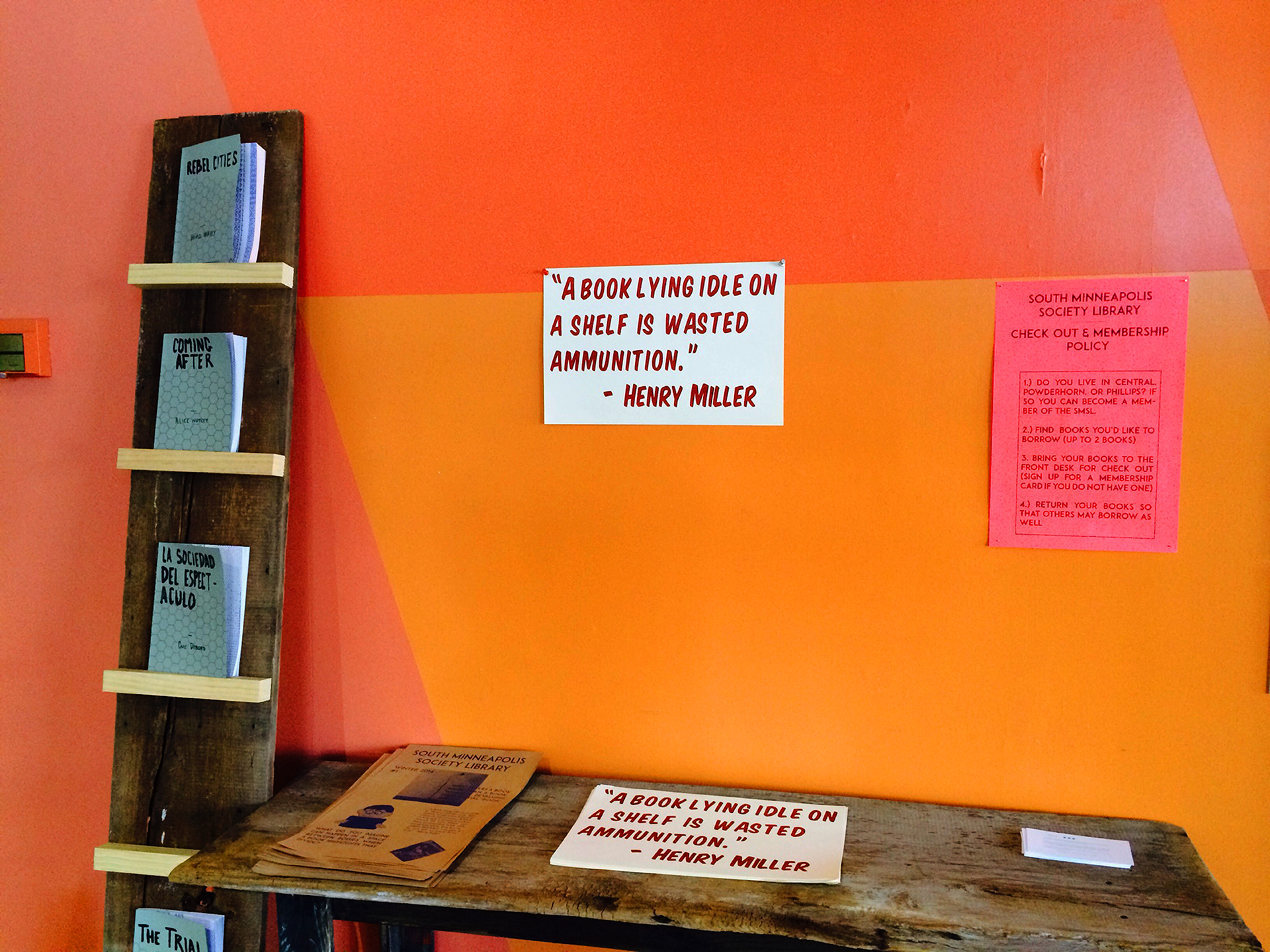
Matt Olson, of ROLU, and now OOIEE, fame came into the shop today. He caught Sam on the phone with a potential customer saying, “you understand we can do this much cheaper than Kinkos right?” Oh, boy…
Already today we’ve had people come in and talk about the role of design in helping us ask questions about ourselves; how maps devised by artists can help us see and imagine a future social landscape differently; whether we can print their zine; if we could help them devise a questionnaire to distribute around the neighborhood asking neighbors what sort of police relations THEY want to see.
All in all I’d say that’s a really good day.
RM < > MR primer…

Food Enough? A Continuing Forum on Food, Land, Access, and Possibilities within the 9th Ward and Beyond
When considering an urban agricultural future, what does it mean for a neighborhood to have *abundant* or at least *enough* food? How is food-producing land part of a desirable vision for land “development” / land use? And in turn, who benefits most directly from a reconsideration of land-use development?
While South Minneapolis’s 9th Ward contains the highest concentration of urban farms within the entire Twin Cities metro area, it remains, nonetheless, a bit of a barren landscape when it comes to accessibility to fresh fruit and produce. Furthermore, while full of vacant, city owned land, Powderhorn, a 9th Ward neighborhood, is the only area within Minneapolis that is statistically gentrifying.
Within the space between these points folks from Twin Cities Agricultural Land Trust, Beyond Repair, and elsewhere have begun an on-going and exploratory conversation regarding food production, land access, and future visions of the city in relation to agriculture, access, and abundance.
Our group converges through a shared interest in the future and history of urban agriculture, the role of land trusts in establishing more equitable land access, and historical legacies and contemporary examples of community cultivated land (and how we can work toward this in the Twin Cities).
Conversation participants will be able to contribute visually and artistically to this process as the group will co-create printed materials that record major themes to be distributed throughout the 9th Ward and, furthermore, to develop questions for future meetings.
* Relaxed atmosphere! No bosses, no teachers! Surrounded by ample beer and food!
** Any conversation concerning land and access within Minnesota, and the country as a whole, needs to be seen through the lens of colonialism and settlement. Inasmuch this series of conversations wants to acknowledge and make clear that it is taking place on Dakota land.

The South Minneapolis Society Library (SMSL) exists as much as a space to enjoy books and the moments they can generate as it does a tool to consider the landscape and actions which often materialize within the space between books, readers, and the publics which are spawned by their convergence. Printed matter, often more visibly than other forms of media, serves as the fill – the rock and soil – of our shared lived experience, and inasmuch, creates a potent and shifting space to critically engage our experiences of living within a shared space and time. Now, in the digital networked age, this potency is not sapped, but heightened and fractured, allowing books and printed materials a special confusing resonance radically altering their specific-use as a technology from what it has been for the most part of the last 500 years.” – text from the South Minneapolis Society Library mission statement (2015, Red76)
In 2015 Red76 housed the South Minneapolis Society Library (SMSL) in the lobby of Pillsbury House at 35th and Chicago Ave. Anyone who lived in the 9th Ward was welcomed to check-out a growing, and often thematic, selection of books. All titles were sourced from the internet, printed and bound.
Beyond Repair is interested in the idea of resurrecting the SMSL on site in the Midtown Global Market, but how would this incarnation be different, if at all, from the last? How else could get involved, and how would a diversity of “librarians” and bookmakers alter the narrative and possibilities of the lending library?
Join us at the shop next Wednesday afternoon to discuss. All unaffiliated librarians, radical nerdists, bibliofreaks, and lovers of the printed word welcome to attend.

You are invited to Beyond Repair in the Midtown Global Market to have your portrait taken and talk about beauty as you see it and its place in our neighborhood.
Along with your beautiful self, bring your favorite painting, drawing, photograph, video, dress, stuffed animal, etc, along with you! In time the accumulated portraits will be made into a book; a document of the Phillips/Powderhorn neighborhoods, its people, and their cherished objects.
An on-going neighborhood portraiture project by the Shoebox Gallery, the results will be made into a book. Participants will be given a free print of their portrait!
Nate Young: “Hey, Sam, this book is amazing. We should all read it together. I can’t think of anything else lately.”
Sam Gould: “Awesome. How about Saturday?”
THE UNDERCOMMONS READING GROUP
We’ll be reading Stefano Harney and Fred Moten’s The Undercommons: Fugitive Planning and Black Study at Beyond Repair. We’ll talk, consider how the text applies to present American realities both across the nation, as well as here in MPLS. We’ll take what we can, and see where it leads.
We’ve printed and bound a few hardcopies to begin with. Come early to get your own – FOR FREE. We’re hoping to read the first section before Sat. 30th of January. If you can’t stop over at Beyond Repair to get a copy, here’s a pdf to begin your reading.
ed. by Anthony Romero & Matthew Joynt
Coming in early March, 2016…
To resist regulation, regimentation, and normalization is the struggle of what has come to be called free jazz, the musical and political culture which emerges in the United States in the 50s and 60s during a time of great social and political upheaval and experimentation.The immediacy and urgency of the art form provides us with, not just an experience, but a framework for thinking about collectivity, individualism, self-determination, and the many ways in which these processes and practices intersect with and enliven one another.
Make no mistakes about it, the implementation of alternative and radical politics, like those that can be found in and around the history of free jazz, at least within the United States, is difficult. Free jazz, like other social practices, is a difficult art. And it should be. NOW is no place for the passive, NOW is the time, and NOW is the place for difficult politics and difficult art.
A series of publications and audio releases, The Revolution in Music / The Music in Revolution faces this difficulty head on, summoning a constellation of ideas and regional histories that confront the relationship between free jazz and radical politics. Highlighting and advocating overlapping social and political practices, through booklets, books, records and more, the series makes current the past, and advocates for the political potentiality of the difficult.
Watching the process of what, I assumed, was the dismantling of the entire house into a vacant lot, I couldn’t help but be upset. It seemed that this, all this, the suicide of our neighbor in the midst of the fear of losing his home; the continued harassment by the city of our former neighbor, political “yard artist” Andrew Moore, to the degree that, after dozens of code violations he did in fact lose his home; the proliferation of abandoned, yet privately owned, properties around the neighborhood that the city seemed to care little about; all of this felt too aggressively normal. By the book to a degree that its disregard for human life became absolved through bureaucracy.”
– from Trash: An Afterlife of Voiceless Objects by Sam Gould (coming soon in the Tools for Remediation booklet series)
Sitting in the shop and thinking about the various ways that Beyond Repair, as a project and not simply a site, needs to utilize publication to move ideas around a neighborhood. For one, when thinking about publication, it’s important to be light on your feet.
Publication, within these circumstances can be both object and / or action, noun and / or verb. Publication acts as the tool to move ideas around. This could mean a book, a zine, a parade, or a protest.
Lasting publications serve the publics they wish to energize and purposely avoid formalism for the sake of promoting agency.
We all need a little help to pull ourselves together right? There’s no difference when it comes to our beloved paperback books that have split their spines, seemingly never to be read again. And yet… we can’t stand the idea of parting with them.
Well, come on down to the shop tonight so we can lend you a hand. Bring whatever damaged books you have and we’ll glue them back together for you.
Pens and markers on hand to draw your own covers. It’s family night. Bring your kids. Imagine what your copy of Crime and Punishment will look like when you have your 6 year old draw the cover. Imagine how they’ll spell Fyodor Dostoevsky.
Re-Bind = $4 per book
$2 “coupon” off your beer at Eastlake with every book purchase.
I’m really impressed with the clarity amidst the complexity of Marlon‘s argument here. While cutting and to the point, its logic opens up a door for each encounter, each action, we take through a precise lens. In regard to so many aspects of power and acquiescence which we encounter daily, it’s exactly the type of question we should be asking of ourselves.
Marlon lives in the building above Beyond Repair, so considering I know he’s watching… MPLS folks, what do you have in mind? How can an expanded view of publication (as in The Act of Public-Making) strengthen anti-racist action and consciousness in the 9th Ward and further? Give it some thought. Have some ideas? Come down to the shop and let’s figure out what we can do to implement it.
Malik is a security guard here in the Midtown GlobalMarket. He’s incredibly friendly, and we often joke around about books we could make together about he and his co-workers experiences on the job. The other day he let us know he has a book that he does want to make, not a joke, but an oral history of the voices of Somali elders – folks his parents age and older – who were able to escape the civil war and come here to Minneapolis.
I’m so excited to help to get this book published. It’s a publication that our neighborhood, and Minneapolis as a whole, needs.
Esme, Sam’s daughter, says: “Every animal needs a break, every one… except for books. They’re like, ‘Keep reading! Keep reading!’ “